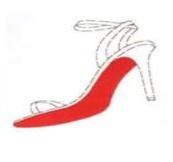(LUXEMBOURG) – Luxury shoe designer Christian Louboutin won a case at the European Court of Justice Tuesday over the right to trademark its exclusive red sole trademark used in high-heeled shoes for women.
The Luxembourg-based Court based its judgement on the fact that a mark consisting of a colour applied to the sole of a shoe is not covered by the prohibition of the registration of shapes. Such a mark does not consist ‘exclusively of the shape’, within the meaning of the trademark directive it said.
In February this year, the company had lost a case when the EU top Court’s advocate-general declared that a trademark combining colour and shape could be refused or declared invalid on the grounds set out under EU trade mark law.
This case, brought by M Louboutin and Christian Louboutin SAS, who design high-heeled shoes for women, centred on the shoes’ feature that the outer sole is always red. Louboutin had registered that trademark in Benelux for ‘footwear’ in 2010, and for ‘high-heeled shoes’ in 2013. The trademark is described as consisting ‘of the colour red (Pantone 18 1663TP) applied to the sole of a shoe as shown (the contour of the shoe is not part of the trade mark but is intended to show the positioning of the mark)’. It is reproduced below:
The Van Haren company operates shoe retail outlets in the Netherlands. In 2012, Van Haren sold high-heeled women’s shoes with red soles. Mr Louboutin and his company brought proceedings before the Netherlands courts seeking a finding of trade mark infringement by Van Haren. The latter claimed that the mark at issue is invalid.
The EU trade mark directive sets out a number of grounds on which registration of a mark may be refused or declared invalid, particularly in relation to signs that consist exclusively of a shape that gives substantial value to the goods. The Dutch authorities referred to the EU Court of Justice in that regard. The issue concerned whether the concept of ‘shape’, within the meaning of the directive, is limited solely to three-dimensional properties of a product, such as its contours, measurements and volume, or whether that concept also covers other characteristics, such as colours.
In today’s judgment, the Court took the view that, since the trade mark directive provides no definition of the concept of ‘shape’, the meaning of that concept must be determined by considering its usual meaning in everyday language. The Court pointed out that it does not follow from the usual meaning of that concept that a colour per se, without an outline, may constitute a ‘shape’.
Furthermore, it could not be held that a sign consists of that shape in the case where the registration of the mark did not seek to protect that shape but sought solely to protect the application of a colour to a specific part of that product.
As the mark does not relate to a specific shape of sole for high-heeled shoes since the description of that mark explicitly states that the contour of the shoe does not form part of the mark and is intended purely to show the positioning of the red colour covered by the registration.
The Court held also that a sign, such as that at issue, cannot, in any event, be regarded as consisting ‘exclusively’ of a shape, where the main element of that sign is a specific colour designated by an internationally recognised identification code.
Judgment in Case C-163/16 Christian Louboutin and Christian Louboutin SAS v Van Haren Schoenen BV


